Previous news items
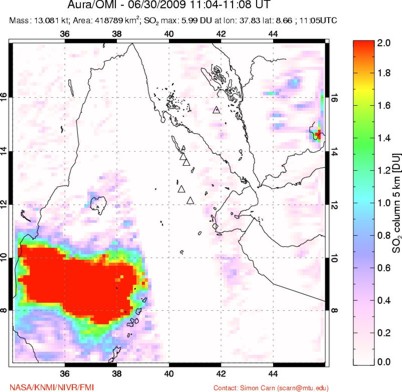
Images of sulphur dioxide emissions taken on 30th June, 2009 from the OMI instrument on NASA’s EOS-Aura satellite. Simon Carn, Michigan Technological University, NOAA Satellite and Information Service (http://satepsanone.nesdis.noaa.gov/pub/OMI/OMISO2/)
Congratulations to Professor Gezahegn Yirgu
4th February, 2010. Congratulations to Professor Gezahegn Yirgu on his promotion to Full Professor of Earth Sciences at Addis Ababa University.
New Eruption in the Dabbahu Segment, Afar (28-29 June, 2009)
On Monday 29th June a new sulphur dioxide cloud was detected by NASA’s EOS-Aura satellite over the southern Afar region. The cloud appears to originate from the Karbahi region of the Dabbahu (Manda-Hararo) rift segment, near to the site of previous fissure eruption in August 2007. The sulphur cloud is a similar size to that of the August 2007 eruption. Hot lava was detected by heat sensitive instruments on NASA’s Terra and Aqua satellites. Meteosat’s fire detection sensor suggests the eruption began at around 17:15 GMT on 28th June, about 7 hours after a magnitude 4.4 earthquake, reported by the European-Mediterranean Seismological Centre.
A team from the Consortium has flown straight out to Afar and hope to visit the eruption site with scientists from Addis Ababa University and the Ethiopian Geological Survey to collect rock and gas samples, as well as photographic and thermal imagery. One of the team, David Ferguson, is keeping a blog of his experiences on the Guardian website http://www.guardian.co.uk/science/blog/2009/jul/03/volcanic-eruption-afar-ethiopia
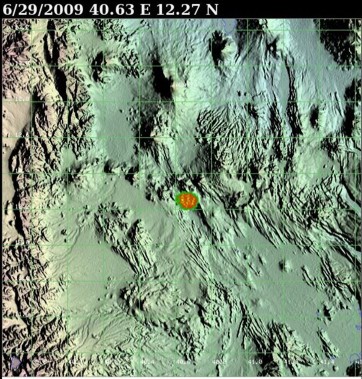
Heat sensitive image from NASA’s Terra and Acqua satellite taken on 29th June, 2009 (http://modis.higp.hawaii.edu)
The Afar region remains one of the most active geological areas on the planet, and the ongoing rifting episode has included the intrusion of 13 volcanic dykes to date. Three of these have resulted in volcanic eruptions but the rest have remained below ground. A separate eruption occurred on the Erta ‘Ale range in November 2008. For more technical information about the ongoing activity see our publications.
We anticipate that further eruptions will occur in the coming years, as the tectonic strain is fully released (Hamling et al., 2009 (PDF file)).
Field report from the eruption site (pdf file)
Photographs from the field of the eruption site
Notes for editors:
1. The Afar Rift Consortium is an international, interdisciplinary collaborative
project funded by the Natural Environment Research Council in the UK and
the US National Science Foundation. It comprises scientists in the UK,
US, France and Ethiopia.
2. Sulphur dioxide measurements were made using the OMI instrument on
NASA’s EOS-Aura satellite: http://satepsanone.nesdis.noaa.gov/pub/OMI/OMISO2/
3. Hot lava is routinely detected by the MODIS instruments on NASA’s
Terra and Acqua satellite, and processed using the MODVOLC algorithm at
the University of Hawaii: http://modis.higp.hawaii.edu
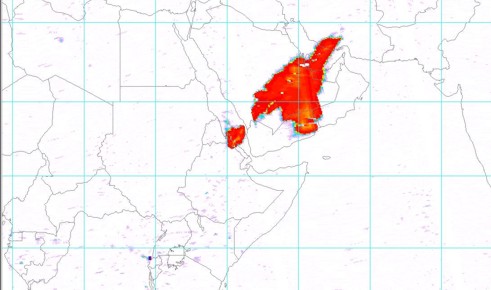
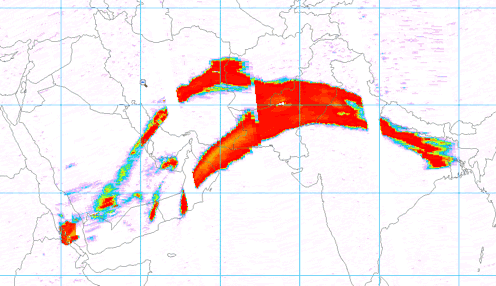
Images of sulphur dioxide emissions taken on 3rd (top) and 5th November, 2008 from the OMI instrument on NASA’s EOS-Aura satellite. Simon Carn, Michigan Technological University, NOAA Satellite and Information Service (http://satepsanone.nesdis.noaa.gov/pub/OMI/OMISO2/)
Congratulations to Dr Elias Lewi
26th January, 2009: Congratulations to Dr Elias Lewi on being appointed the new Director of the Institute of Geophysics Space Science and Astronomy (IGSSA) at Addis Ababa University.
New Eruption in Afar - Erta 'Ale November 2008
On Tuesday 4th November, scientists using satellites to monitor sulphur dioxide emissions (http://satepsanone.nesdis.noaa.gov/pub/OMI/OMISO2/) noticed a large anomaly emanating from the Afar region of Northern Ethiopia (Figure 1). Quickly, heat sensitive satellites showed that an eruption had begun near the Dala Filla volcano in the Erta ‘Ale volcanic range on 3rd November (Figure 2). Local people reported earthquakes and bright lights around the volcano. Erta ‘Ale has had an active lava lake (Figure 3) since records began (at least 120 years), but there is no recorded eruption from any other volcano in the range. Early indications are that this could be Ethiopia largest eruption known in historic times.
The Afar region is being stretched as the Arabian and African plates move apart, and eventually a new ocean may form – the area around Erta ‘Ale is already below sea level. Scientists in the Afar Rift Consortium will be analysing ground deformation and seismicity associated with the recent eruption, and hope to collect samples of the lava in the field when it is safe to do so. Eruptions on this scale are rare, and offer an opportunity to understand how the Earth’s crust is forming. The last few years have been unusually active in Afar, with three eruptions having occurred since 2005. Prior to this, the last eruptive activity in Ethiopia occurred between 1968 and 1973 when the lava lake at Erta 'Ale overspilled.
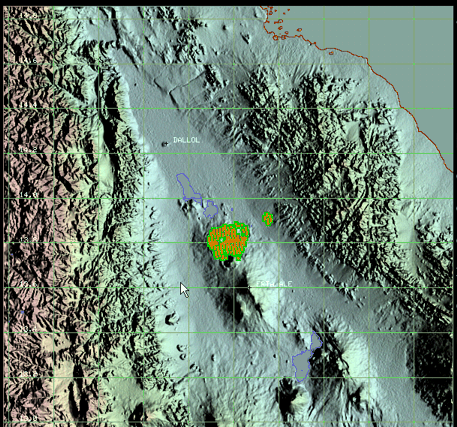
Heat sensitive image from NASA’s Terra and Acqua satellite taken on 3rd November, 2008 (http://modis.higp.hawaii.edu)
The ASTER sensor on NASA's Terra satellite showed the extent of the new
lava and was used as NASA's image of the day on 19 November 2008:
http://earthobservatory.nasa.gov/IOTD/view.php?id=35926
Notes for editors:
1. The Afar Rift Consortium is an international, interdisciplinary collaborative
project funded by the Natural Environment Research Council in the UK and
the US National Science Foundation. It comprises scientists in the UK,
US, France and Ethiopia.
2. Sulphur dioxide measurements were made using the OMI instrument on
NASA’s EOS-Aura satellite: http://satepsanone.nesdis.noaa.gov/pub/OMI/OMISO2/
3. Hot lava is routinely detected by the MODIS instruments on NASA’s
Terra and Acqua satellite, and processed using the MODVOLC algorithm at
the University of Hawaii: http://modis.higp.hawaii.edu
Congratulations to Jon Blundy
16th May, 2008: Jon Blundy has been made a Fellow of the Royal Society for his 'fundamental contributions to understanding the generation and movement of magma within the earth. The breadth of his work is impressive, ranging from field studies of the emplacement mechanisms of granites and volcanic rocks, through experimental petrology and thermodynamics applied to igneous systems, to study of the oxidation state of the mantle. His most recent programme has combined a wide range of field, analytical and laboratory skills to quantifying the pressure-temperature paths followed by magmas as they ascend beneath volcanoes, and has cast important new light on the evolution of magmas immediately before major eruptions.'
http://royalsociety.org/publication.asp?id=7713
New Dyke Injection (12th April 2008)
Evidence from interferograms suggests a new dyke is being injected into the crust beneath the southern end of the Dabbahu rift segment in the Afar Depression. Activity started some time between the 13th February and 7th April 2008. The dyke is at the southern end of the rift segment and at the northern end of a dyke injected during November 2007. Activity shows no sign of stopping. A swarm of earthquakes were also observed between 31st March and 1st April which may be associated with the dyke injection.
